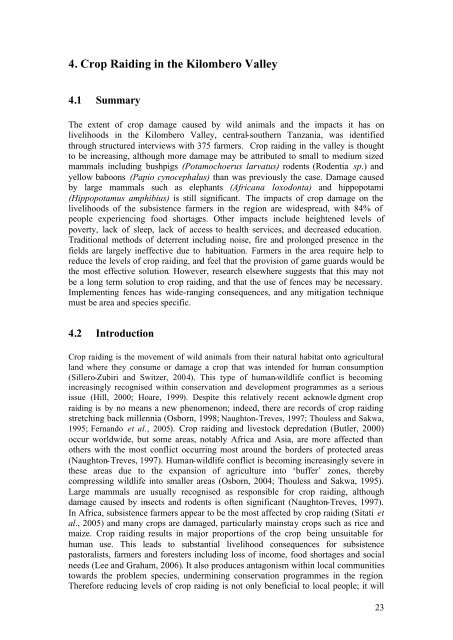Frontier Tanzania Environmental Research - Frontier-publications ...
Frontier Tanzania Environmental Research - Frontier-publications ...
Frontier Tanzania Environmental Research - Frontier-publications ...
You also want an ePaper? Increase the reach of your titles
YUMPU automatically turns print PDFs into web optimized ePapers that Google loves.
4. Crop Raiding in the Kilombero Valley4.1 SummaryThe extent of crop damage caused by wild animals and the impacts it has onlivelihoods in the Kilombero Valley, central-southern <strong>Tanzania</strong>, was identifiedthrough structured interviews with 375 farmers. Crop raiding in the valley is thoughtto be increasing, although more damage may be attributed to small to medium sizedmammals including bushpigs (Potamochoerus larvatus) rodents (Rodentia sp.) andyellow baboons (Papio cynocephalus) than was previously the case. Damage causedby large mammals such as elephants (Africana loxodonta) and hippopotami(Hippopotamus amphibius) is still significant. The impacts of crop damage on thelivelihoods of the subsistence farmers in the region are widespread, with 84% ofpeople experiencing food shortages. Other impacts include heightened levels ofpoverty, lack of sleep, lack of access to health services, and decreased education.Traditional methods of deterrent including noise, fire and prolonged presence in thefields are largely ineffective due to habituation. Farmers in the area require help toreduce the levels of crop raiding, and feel that the provision of game guards would bethe most effective solution. However, research elsewhere suggests that this may notbe a long term solution to crop raiding, and that the use of fences may be necessary.Implementing fences has wide-ranging consequences, and any mitigation techniquemust be area and species specific.4.2 IntroductionCrop raiding is the movement of wild animals from their natural habitat onto agriculturalland where they consume or damage a crop that was intended for human consumption(Sillero-Zubiri and Switzer, 2004). This type of human-wildlife conflict is becomingincreasingly recognised within conservation and development programmes as a seriousissue (Hill, 2000; Hoare, 1999). Despite this relatively recent acknowle dgment cropraiding is by no means a new phenomenon; indeed, there are records of crop raidingstretching back millennia (Osborn, 1998; Naughton-Treves, 1997; Thouless and Sakwa,1995; Fernando et al., 2005). Crop raiding and livestock depredation (Butler, 2000)occur worldwide, but some areas, notably Africa and Asia, are more affected thanothers with the most conflict occurring most around the borders of protected areas(Naughton-Treves, 1997). Human-wildlife conflict is becoming increasingly severe inthese areas due to the expansion of agriculture into ‘buffer’ zones, therebycompressing wildlife into smaller areas (Osborn, 2004; Thouless and Sakwa, 1995).Large mammals are usually recognised as responsible for crop raiding, althoughdamage caused by insects and rodents is often significant (Naughton-Treves, 1997).In Africa, subsistence farmers appear to be the most affected by crop raiding (Sitati etal., 2005) and many crops are damaged, particularly mainstay crops such as rice andmaize. Crop raiding results in major proportions of the crop being unsuitable forhuman use. This leads to substantial livelihood consequences for subsistencepastoralists, farmers and foresters including loss of income, food shortages and socialneeds (Lee and Graham, 2006). It also produces antagonism within local communitiestowards the problem species, undermining conservation programmes in the region.Therefore reducing levels of crop raiding is not only beneficial to local people; it will23
















